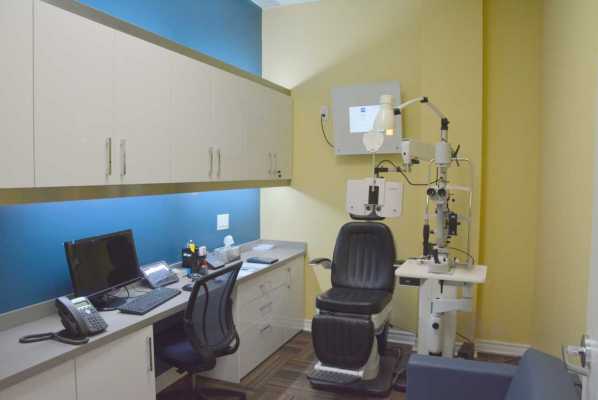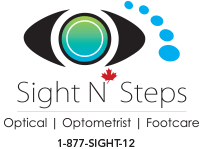Sight N' Steps Blog
- Font size: Larger Smaller
- Subscribe to this entry
- Bookmark

Slit Lamp Exam
A slit lamp is a binocular microscope (or "biomicroscope") that your eye doctor uses to examine the structures of your eye under high magnification. It looks somewhat like a large, upright version of a microscope used in a science lab.
During the slit lamp exam, you will be asked to place your forehead and chin securely against the rests on the front of the instrument and your doctor will begin by examining the structures of the front of your eyes — including your eyelids, cornea, conjunctiva, iris, and lens.
With the help of a hand-held lens, your doctor may also use the slit lamp to examine structures located farther back in the eye, such as the retina and optic nerve.
A wide range of eye conditions and diseases can be detected with the slit lamp exam, including cataracts, macular degeneration, corneal ulcers and diabetic retinopathy, etc.
The Glaucoma Test
Testing for glaucoma typically begins with measuring the pressure inside your eyes.
A common glaucoma test is the "puff-of-air" test, technically known as non-contact tonometry, or NCT. (This test was immortalized on the hit TV show Friends, when Rachel couldn't sit still for it.)
For NCT, the test begins with you putting your chin on the machine's chin rest. While you look at a light inside the machine, the doctor or a trained assistant will puff a small burst of air at your open eye. It is completely painless, and the tonometer does not touch your eye.
Based on your eye's resistance to the puff of air, the machine calculates your intraocular pressure (IOP). If you have high eye pressure, you may be at risk for or have glaucoma.
Another type of glaucoma test is performed with an instrument called an applanation tonometer. The most common of several versions of this instrument is mounted on the slit lamp.
For this test, your eye doctor will put yellow eye drops in your eye to numb it. Your eyes will feel slightly heavy when the drops start working. This is not a dilating drop — it is a numbing agent combined with a yellow dye that glows under a blue light. Then the doctor will have you stare straight ahead into the slit lamp while he or she gently touches the surface of your eye with the tonometer to measure your IOP.
Like NCT, applanation tonometry is painless. At most, you may feel the tonometer probe tickle your eyelashes. The whole test takes just a few seconds.
You typically have no warning signs of glaucoma until you already have significant vision loss. For this reason, routine eye exams that include tonometry are essential to rule out early signs of glaucoma and protect your eyesight.
Pupil Dilation
To obtain a better view of the eye's internal structures, your eye doctor instills dilating drops to enlarge your pupils. Dilating drops usually take about 20 to 30 minutes to start working.
When your pupils are dilated, you will be sensitive to light (because more light is getting into your eye) and you may notice difficulty focusing on objects up close. These effects can last for up to several hours, depending on the strength of the drop used.
Once the drops have taken effect, your eye doctor will use various instruments to look inside your eyes. You should bring sunglasses with you to your eye exam, to minimize glare and light sensitivity on the way home. If you forget to bring sunglasses, the staff usually will give you a disposable pair.
Pupil dilation is very important for people with risk factors for eye disease, because it allows for the most thorough evaluation of the health of the inside of your eyes.
Visual Field Test
In some cases, your eye doctor may want to check for the possible presence of blind spots (scotomas) in your peripheral or "side" vision by performing a visual field test. These types of blind spots can originate from eye diseases such as glaucoma.
Analysis of blind spots also may help identify specific areas of brain damage caused by a stroke or tumor.
Other Eye Tests
In some cases, besides these common tests performed during a standard comprehensive eye exam, your eye doctor may recommend other, more specialized eye tests. Often, such tests are performed by other eye doctors, such as retinal specialists, on a referral basis.
About Contact Lens Fittings
It's important to understand that a comprehensive eye exam typically does not include a contact lens fitting, and therefore you will not be given a contact lens prescription at the end of a routine eye exam.
There is a possible exception: If you wear contacts currently and the lenses were fitted by the same eye doctor who is performing your comprehensive eye exam, he or she may issue you an updated contact lens prescription at the end of your eye exam.
A contact lens exam that includes fitting services typically is done during a subsequent office visit, when your pupils are not dilated. Your contact lens exam may be performed by the same eye doctor who performed your comprehensive eye exam, or it may be done by a different eye care practitioner (ECP).
Generally, it's better to have your eye exam and your contact lens exam performed at the same practice. Sometimes, if you have these exams performed at different locations, the ECP conducting your contact lens fitting will want to repeat certain tests already performed at your comprehensive eye exam. In part, this is done for liability reasons — to verify the accuracy of your eyeglasses prescription and make sure your eyes are healthy enough to wear contacts.
- Sight N' Steps Optometrists Pickering - So What Do...
- Why Do You Keep Talking About Quality? Lenses Are ...
- Hey Where Is Your New Pickering Location At? - Sight N' Steps Oct 07
- So What's New At Sight N' Steps Pickering Town Centre Location? - Sight N' Steps Oct 14
- German Engineering At Sight N Steps Pickering Optical | Optometrist | Footcare - Sight N' Steps Oct 18
- Sight N' Steps Optometrist Pickering Town Centre Partners Up With Givenchy - Sight N' Steps Oct 19
- So How Do My Cat Eyes Look This Halloween? - Sight N' Steps Oct 23



